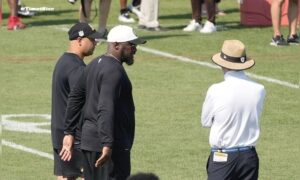Yesterday, I talked about the Rooney Rule a bit and how it came to be 12 years ago, noting the Pittsburgh Steelers’ role in implementing it and in their track record for employing minority coaches. In addition to head coach Mike Tomlin, the Steelers coaching staff includes six other minority coaches.
Of course, the Rooney Rule only applies to the head coaching position, as well as front office senior football operations positions, and not to coordinator or position coach job openings. That is, in fact, what many regard as one of the shortcomings of the Rooney Rule, and perhaps its next frontier.
Having only touched upon its impact yesterday, however, I felt that perhaps a bit more involved discussion about its role in reshaping the culture and landscape of the coaching position in the NFL would be well served.
As I wrote yesterday, since its adaptation in 2003, 10 different minority head coaches have been given their first opportunity on a non-interim basis, a number that obviously includes the Steelers’ own head coach, who became the youngest coach to win a Super Bowl.
Beyond that, of the 87 head coaching and front offices positions having been filled in that timeframe, 17 of them have gone to minority candidates, which has been a significant improvement over the previous rate.
Opponents of the Rooney Rule have presented several different arguments, and indeed, there are some flaws. Every rule is imperfect to some degree. One of the main points of contention is that it creates phantom interviews for token minority candidates.
Indeed, some of the applicants themselves no doubt feel this way. But others see the tangible benefits from even getting the opportunity to go on interviews they would otherwise not even see.
It paid off, perhaps, for the most recent minority head coach, Todd Bowles, who has gone on several interviews over the years. He is, by reports, not a natural interview, but through repetition, he was able to learn what it takes to navigate the process successfully, and he was recently awarded with the head coaching position with the New York Jets.
Prior to the institution of the Rooney Rule, hirings too often took the form of citing the well-worn rolodex of names already known to the coaching circles, creating a shallow pool of recycled candidates that at the same time keeps new candidates at a distance. Because minority coaches were not already a part of that inner circle, they in particular were historically excluded.
The above also touches on one of the other major critiques of the Rooney Rule, which is that, occasionally, teams already have a candidate in mind that they want to hire—one that perhaps they made other moves in order to be able to land. In that case, surely they should not be forced to go through the motions.
But the truth is that there is still a great deal of untapped potential within the ranks of minority coaches that many are not even aware of because they have had limited opportunities to show it. At least if they are given the opportunity to present themselves, then word could be passed on to other teams.
The Rooney Rule may never be perfect, but it has shown a propensity to evolve over time, and should continue to do so. Overall, it has accomplished its goal. But work must also be done to help prepare more minorities for coaching opportunities, in conjunction with granting them more exposure to those opportunities, and that’s something that a rule can’t address on its own.








